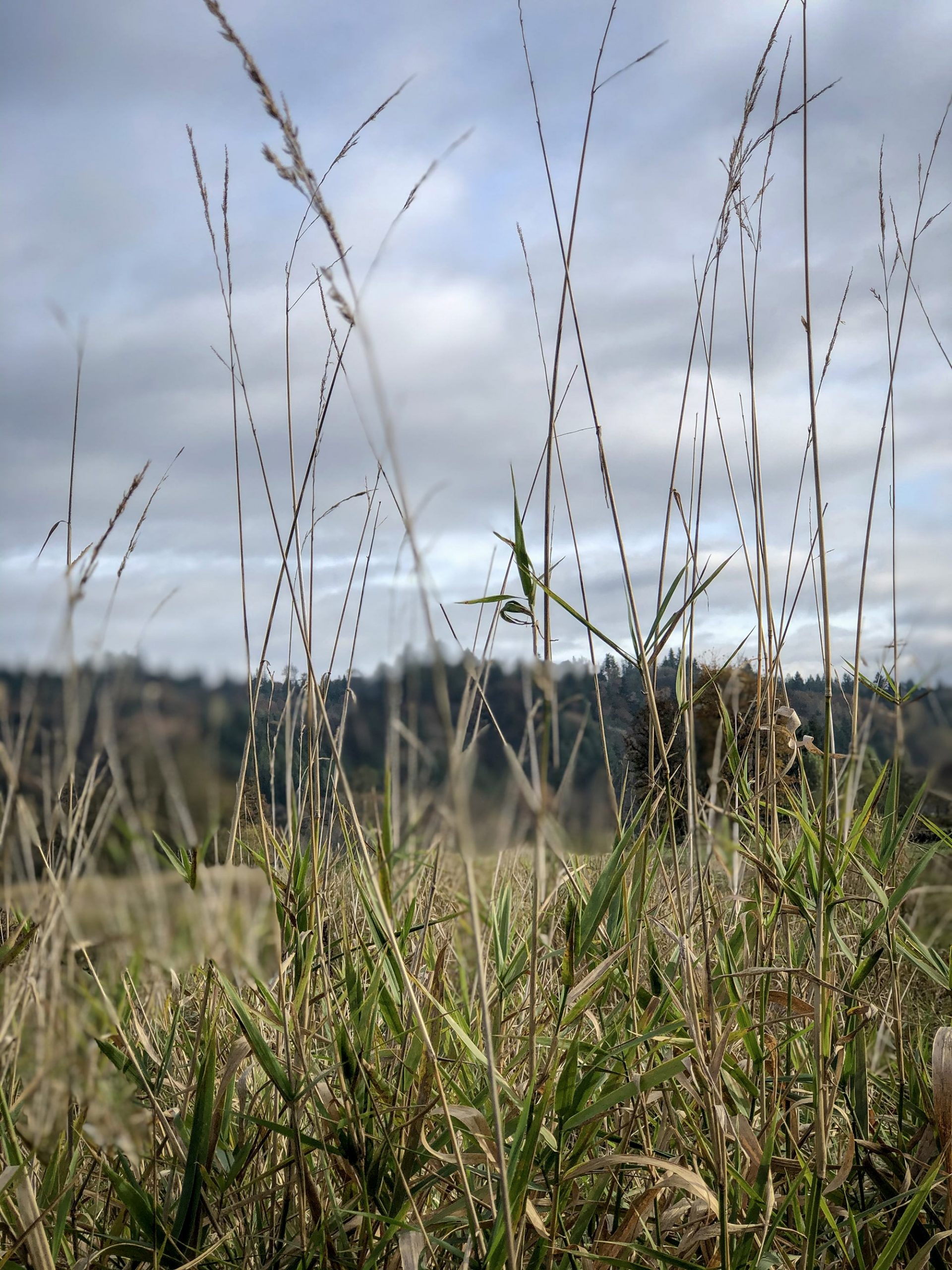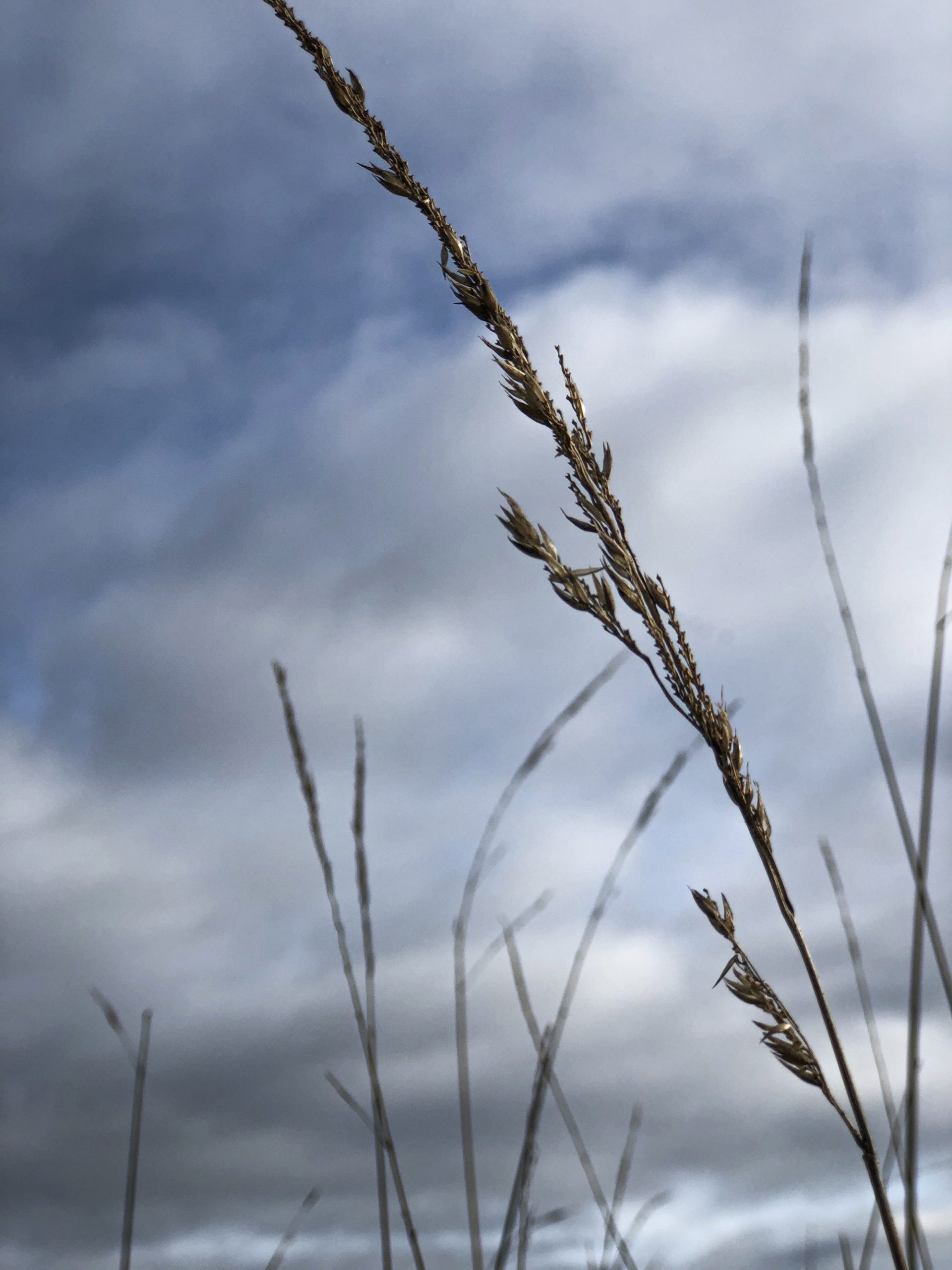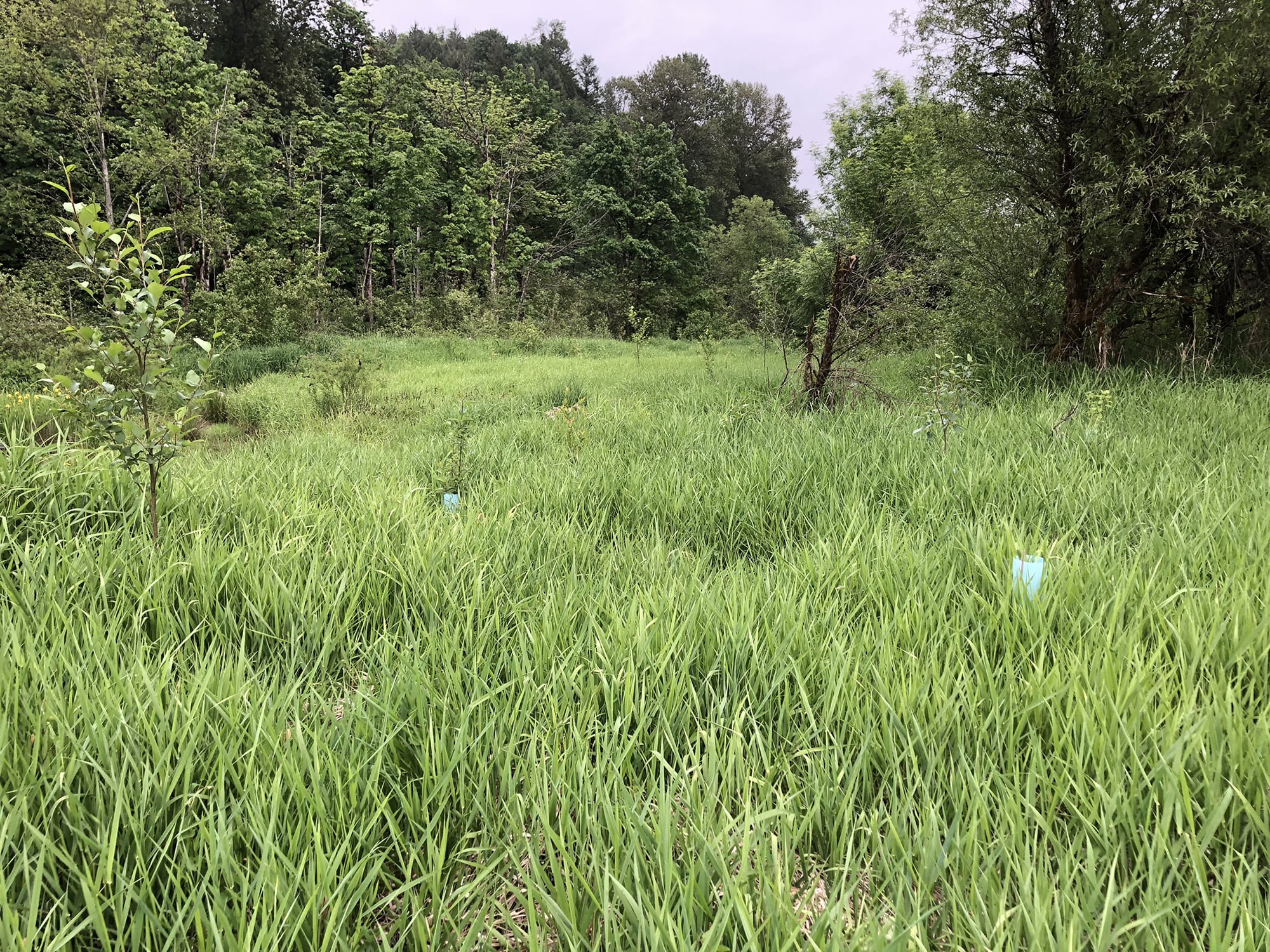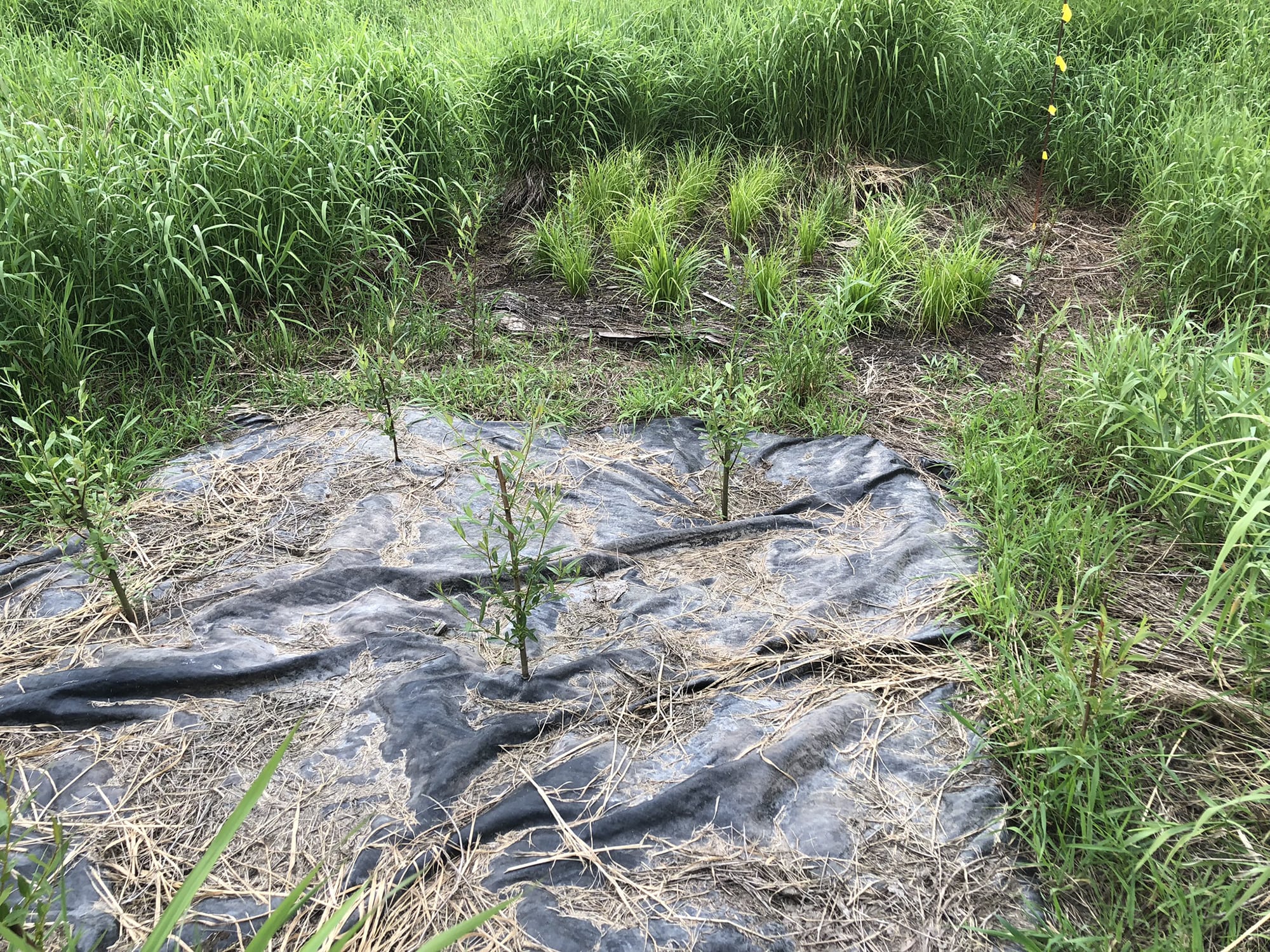Reed Canarygrass
Characteristics
 Reed canarygrass (Phalaris arundinacea) is a tall grass that grows between three to nine feet in height. It has hairless green stems; large, compact flowering heads; and broad, hairless, green leaves with long ligules at the base. If you’ve looked out your window at the grassy wetlands in the Snoqualmie Valley, you’ve seen reed canarygrass. Its most vigorous growth is from June to August. In June and July, it flowers with a purplish hue and remains tall even as it dries out in late summer and fall. The dried stalks form dense mounds that can be up to 1.5 feet deep. This is often what prevents seedlings from other species from taking root. It spreads by seed and by forming mats of rhizomes. It loves wet soils and sunny locations and will take over any area that meets those specifications once it is established.
Reed canarygrass (Phalaris arundinacea) is a tall grass that grows between three to nine feet in height. It has hairless green stems; large, compact flowering heads; and broad, hairless, green leaves with long ligules at the base. If you’ve looked out your window at the grassy wetlands in the Snoqualmie Valley, you’ve seen reed canarygrass. Its most vigorous growth is from June to August. In June and July, it flowers with a purplish hue and remains tall even as it dries out in late summer and fall. The dried stalks form dense mounds that can be up to 1.5 feet deep. This is often what prevents seedlings from other species from taking root. It spreads by seed and by forming mats of rhizomes. It loves wet soils and sunny locations and will take over any area that meets those specifications once it is established.
Why is it here? Why don’t we want it here?
 Reed canarygrass is native to Eurasia. Though possibly, there is a variety native to North America as well. There is no definitive way to tell which grass belongs to which continent; but we do know that it was not nearly as common before it was brought over from Europe. The European variety was used for hay and forage production in the Pacific Northwest; although it can cause indigestion in livestock. It was also regularly used for soil stabilization. Though it is not a great option for this task either since the sod can be undermined and increase erosion. The plants create a thick thatch and a dense shade that prevents any seedling plants from growing among them. This means that an area with reed canarygrass often loses all species diversity and becomes a monoculture. It can provide limited habitat for some bird species that tolerate or prefer wet grasslands. But on the whole, it provides very limited habitat for wildlife. Reed canarygrass can also clog narrow waterways, making flooding more likely and more challenging for young salmon to find their way to the main channels of rivers. Topping things off, it is also a common allergen for people. Many of us can thank reed canarygrass for our runny noses and constant sneezing.
Reed canarygrass is native to Eurasia. Though possibly, there is a variety native to North America as well. There is no definitive way to tell which grass belongs to which continent; but we do know that it was not nearly as common before it was brought over from Europe. The European variety was used for hay and forage production in the Pacific Northwest; although it can cause indigestion in livestock. It was also regularly used for soil stabilization. Though it is not a great option for this task either since the sod can be undermined and increase erosion. The plants create a thick thatch and a dense shade that prevents any seedling plants from growing among them. This means that an area with reed canarygrass often loses all species diversity and becomes a monoculture. It can provide limited habitat for some bird species that tolerate or prefer wet grasslands. But on the whole, it provides very limited habitat for wildlife. Reed canarygrass can also clog narrow waterways, making flooding more likely and more challenging for young salmon to find their way to the main channels of rivers. Topping things off, it is also a common allergen for people. Many of us can thank reed canarygrass for our runny noses and constant sneezing.
What is Oxbow doing about reed canarygrass?
Reed canarygrass is common throughout wetlands in the Pacific Northwest, and that includes Oxbow’s lowland spaces. You can spot seasonally wet areas just by looking where reed canarygrass grows. We have taken some measures to reduce growth through restoring specific parts of our landscapes. But we haven’t made a push to entirely eradicate it from the property. Because it is so common and so persistent, we have taken a site-by-site approach to managing it.

If reed canarygrass is established in a place we are not yet restoring, or in a field that we are managing as a grassland, we have decided to let it continue to grow. It still provides habitat for grassland birds and a variety of mammals that wouldn’t be well served if we were to mow it regularly. Regular mowing does not kill reed canarygrass, but it can prevent it from going to seed (no allergies). Mowing also reduces the thickness of the mats that are formed. We are only mowing reed canarygrass where we are trying to create landscaped spaces for visitor use, adjacent to farm fields, and in young restoration sites.
In areas where we are trying to restore forest habitats, we are densely planting trees and shrubs and we are mowing regularly between the plants so they don’t get shaded out by reed canary grass. As the plants get taller than the grasses, the grasses tend have less of an impact on the native plants. And as a shady canopy develops, the grass tends to die back due to lack of sunlight. When we plant an area invaded by reed canarygrass, we like to use plants like red alder and willow for their speedy growth. We plant shrubs like snowberry, rose, and salmonberry for their tendency to spread and take over. We also like conifers for their ability to provide shade year-round.
Because not all wetlands are meant to be deeply shaded, we are now experimenting with ways to outcompete reed canarygrass without the use of tree shade. We are experimenting with sheet mulching and landscaping fabric and planting highly competitive sedges in order to create an open-canopy wetland that is not a sea of reed canarygrass. The experiment is still in early stages, but we are excited and hopeful that we will find a way.

What you can do about reed canarygrass on your property
Reed canarygrass is very widespread in King County and is not required to be controlled. While digging up reed canarygrass can be effective for a very small patch, it is usually impractical and ineffective for anything bigger than a few square feet. If you try manual control, make sure you clean your shoes, clothes, and tools afterwards to prevent the spread of seeds to other areas of your property.
Here at Oxbow, and for many groups hoping to restore habitats, the question is not how to get rid of reed canarygrass, but rather what do you want to see growing in a specific location. If you are envisioning a forest, then you’ll want to pick some fast-growing trees that can create canopy, as well as evergreen trees for year-round canopy, and some competitive shrubs for the understory canopy. Density will be key. Mowing or using some sort of cover while your trees grow will also be important to your success. If you are looking to create a more open habitat, success may be much harder. Often times people will resort to mowing reed canarygrass, which won’t kill it, but will keep it knocked back and may allow other plants to grow. You could also use sheet mulching or fabric cover and then sow your desired plants through the cover. Any of these options will require a lot of maintenance to keep reed canarygrass from taking over again.
King County Noxious Weed Control Program has a document on Best Management Practices for reed canarygrass on their website. They discuss all sorts of additional treatment options in much more detail. For more information about reed canarygrass, check out King County Noxious Weeds.
